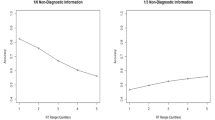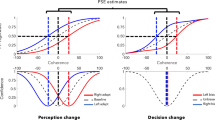Abstract
An integrated, computer-based system was developed to record participants’ continuous judgment changes on a revised form of the Interpersonal Perception Task (IPT-15). Consistent with the considerable research on “thin slice” judgments, the mean latency for greater than chance accuracy confidence was just 16 s (median = 10 s) for the ten one-part scenes on the IPT. There was also a clear and strong linear trend for increasing accuracy confidence across the first 25 s of the ten one-part scenes. For the five-two-part scenes, where comparative judgments were required (e.g., which statement is truthful, which is a lie?), no clear pattern of increasing accuracy confidence was found, with mean scores hovering near chance. The utility of the new system for analyzing the time course of social judgments is discussed and the potential reasons for the contrasting results for the one-part and two-part scenes were examined.


Similar content being viewed by others
References
Albright, L., Kenny, D. A., & Malloy, T. E. (1988). Consensus in personality judgments at zero-acquaintance. Journal of Personality and Social Psychology, 55, 387–395.
Ambady, N., Bernieri, F. J., & Richeson, J. A. (2000). Towards a histology of social behavior: Judgmental accuracy from thin slices of the behavioral stream. In M. P. Zanna (Ed.), Advances in experimental social psychology (pp. 201–272). Boston: Academic Press.
Ambady, N., Hallahan, M., & Rosenthal, R. (1995). On judging and being judged accurately in zero-acquaintance situations. Journal of Personality and Social Psychology, 69, 518–529.
Ambady, N., & Rosenthal, R. (1992). Thin slices of behavior as predictors of interpersonal consequences: A meta-analysis. Psychological Bulletin, 111, 256–274.
Bargh, J. A. (1997). The automaticity of everyday life. In R. S. Wyer (Ed.), The automaticity of everyday life: Advances in social cognition (Vol. 10, pp. 1–61). Mahwah, NJ: Erlbaum.
Cohen, J. (1977). Statistical power for the behavioral sciences. New York: Academic Press.
Costanzo, M., & Archer, D. (1989). Interpreting the expressive behavior of others: The interpersonal perception task. Journal of Nonverbal Behavior, 13, 225–235.
Costanzo, M., & Archer, D. (Producers). (1993). Interpersonal perception task-15 [videotape]. (Available from the University of California Extension Center for Media and Independent Learning, 2000 Center Street, Berkeley, CA 94704).
Freeman, J. B., Ambady, N., Rule, N. O., & Johnson, K. L. (2008). Will category cue attract you? Motor output reveals dynamic competition across person construal. Journal of Experimental Psychology: General, 137, 673–690.
Funder, D. C. (1987). Errors and mistakes: Evaluating the accuracy of social judgment. Psychological Bulletin, 101, 75–91.
Gray, H. M., & Ambady, N. (2006). Methods for the study of nonverbal communication. In V. Manusov & M. L. Patterson (Eds.), The Sage handbook of nonverbal communication (pp. 41–58). Thousand Oaks CA: Sage.
Hall, J. A. (2001). The PONS test and the psychometric approach to measuring interpersonal sensitivity. In J. A. Hall & F. J. Bernieri (Eds.), Interpersonal sensitivity: Theory and measurement (pp. 143–160). Mahwah, NJ: Erlbaum.
Hall, J. A., & Carter, J. D. (1999). Gender-stereotype accuracy as an individual difference. Journal of Personality and Social Psychology, 77, 350–359.
Iizuka, Y., Patterson, M. L., & Matchen, J. (2002). Accuracy and confidence on the interpersonal perception task: A Japanese-American comparison. Journal of Nonverbal Behavior, 26, 159–174.
Jones, E. E., & Davis, K. E. (1965). From acts to dispositions: The attribution process in person perception. In L. Berkowitz (Ed.), Advances in experimental social psychology (Vol. 2, pp. 219–266). New York: Academic Press.
Lakin, J. L. (2006). Automatic cognitive processes and nonverbal communication. In V. Manusov & M. L. Patterson (Eds.), The Sage handbook of nonverbal communication (pp. 59–77). Thousand Oaks, CA: Sage.
Patterson, M. L., Foster, J. L., & Bellmer, C. D. (2001). Another look at accuracy and confidence in social judgments. Journal of Nonverbal Behavior, 25, 207–219.
Patterson, M. L., & Stockbridge, E. (1998). Effects of cognitive demand and judgment strategy on person perception accuracy. Journal of Nonverbal Behavior, 22, 253–263.
Riggio, R. E. (2006). Nonverbal skills and abilities. In V. Manusov & M. L. Patterson (Eds.), The Sage handbook of nonverbal communication (pp. 59–77). Thousand Oaks, CA: Sage.
Smith, H. J., Archer, D., & Costanzo, M. (1991). “Just a hunch:” Accuracy and awareness in person perception. Journal of Nonverbal Behavior, 15, 3–18.
Spivey, M. J., Grosjean, M., & Knoblich, G. (2005). Continuous attraction toward phonological competitors. Proceedings of the National Academy of Sciences, 102, 10393–10398.
Swann, W. B., Jr. (1984). Quest for accuracy in person perception: A matter of pragmatics. Psychological Review, 91, 457–477.
Vrij, A. (2006). Communication and deception. In V. Manusov & M. L. Patterson (Eds.), The Sage handbook of nonverbal communication (pp. 341–358). Thousand Oaks, CA: Sage.
Willis, J., & Todorov, A. (2006). First impressions: Making up your mind after a 100-ms exposure to a face. Psychological Science, 17, 592–598.
Zebrowitz, L. A., & Collins, M. A. (1997). Accurate social perception at zero acquaintance: The affordances of a Gibsonian approach. Personality and Social Psychology Review, 1, 204–233.
Acknowledgments
We are grateful for the particularly insightful and helpful comments of two anonymous reviewers.
Author information
Authors and Affiliations
Corresponding author
Rights and permissions
About this article
Cite this article
Patterson, M.L., Tubbs, M.E., Carrier, G. et al. Temporal Patterns of Accuracy Confidence in Social Judgments: A New Method and Initial Results. J Nonverbal Behav 33, 239–249 (2009). https://doi.org/10.1007/s10919-009-0072-3
Received:
Accepted:
Published:
Issue Date:
DOI: https://doi.org/10.1007/s10919-009-0072-3




